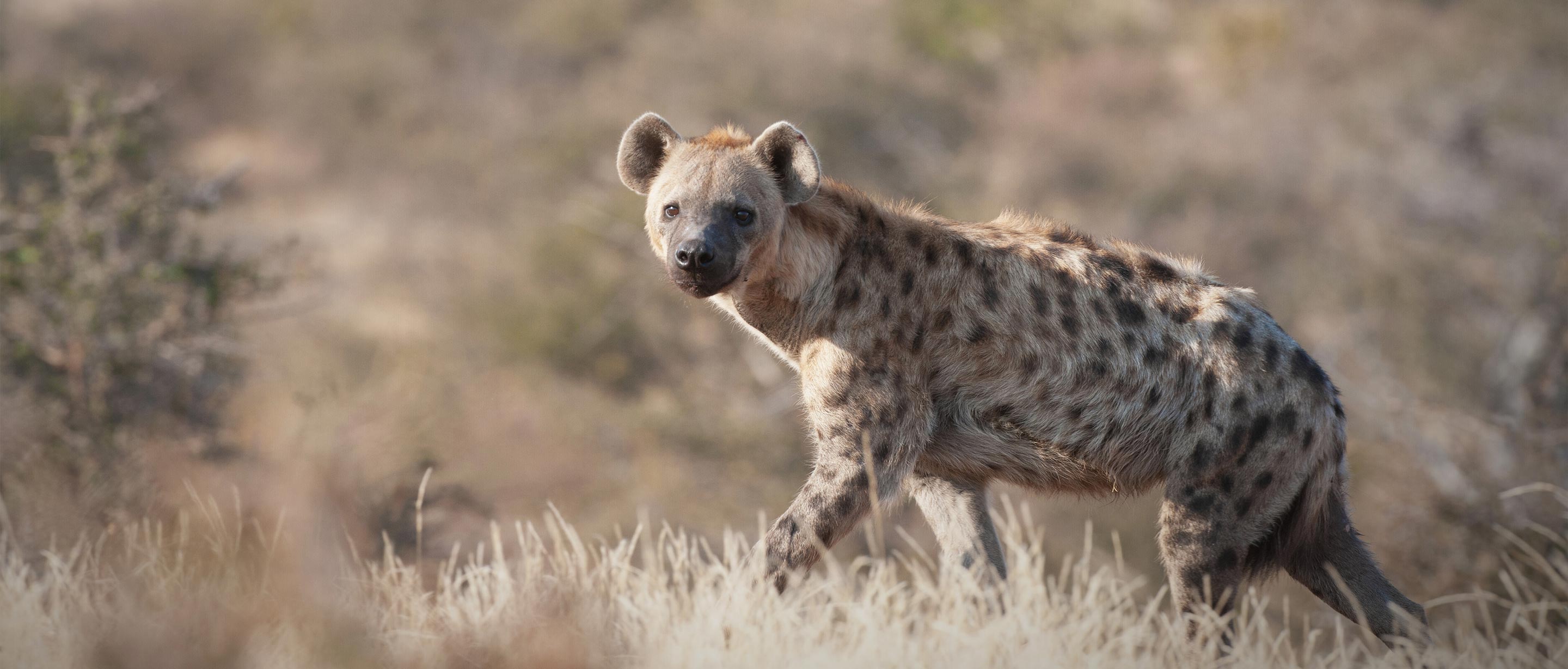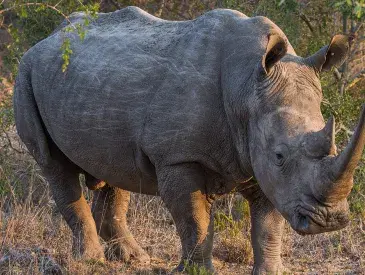What are hyenas?
The hyena (spelled “hyaena” in some parts of the world) is Africa’s most common large carnivore. There are three hyena species — spotted, brown, and striped. Spotted hyenas are the largest of the three. They are fairly large in build and have relatively short torsos with lower hindquarters, and sloping backs. They have excellent night-time vision and hearing.
Crocuta crocuta (spotted hyena), Hyaena hyaena (striped hyena), Parahyaena brunnea (brown hyena)
About 35 to 80 kilograms (77 to to 176 pounds)
95 to 150 centimeters in length (37 to 60 inches); 75 to 85 centimeters at the shoulder (30 to 33 inches)
Up to 20 years in the wild and 25 years in captivity
Savannas, grasslands, woodlands, forest edges, sub deserts and mountains up to 4,000 meters (13,000 feet)
Carnivorous
90 to 110 days
Humans
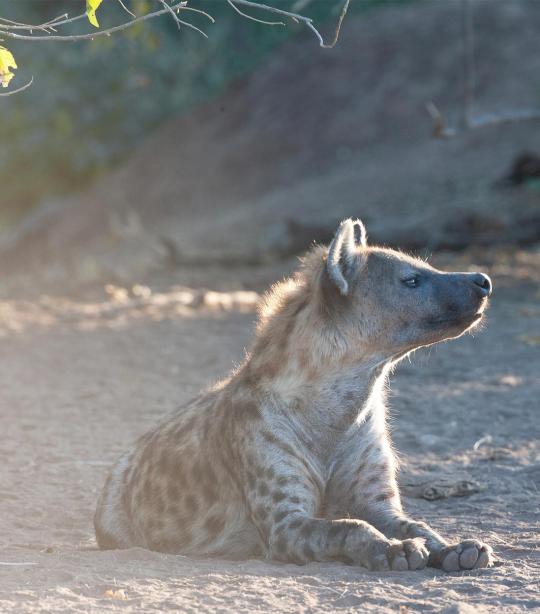
Challenges
Human-wildlife conflict is a major threat to hyenas.
Like many carnivores, hyenas come into conflict with humans when they prey on livestock. They are often seen as a pest species, which often results in retaliatory killings by farmers — especially by poisoning.
Humans are encroaching on hyenas’ habitats.
As human populations expand and growth of agriculture, settlements, and roads results, wildlife is losing space in which it was previously able to roam freely.
Solutions
Our solutions to protecting the hyena:
Retaliation is the primary reason for hyena killings. We work with communities to help them construct bomas — livestock enclosures — that protect livestock from predators and ultimately mitigates human-wildlife conflict.
African Wildlife Foundation’s researchers are working to gain an understanding of large carnivores’ — including hyenas’ — populations, behaviors, movements, and interactions with people to develop appropriate conservation actions. Since 2002, our Large Carnivore Research Project has undertaken research aimed at ensuring the continued survival of large predators living around Botswana, Namibia, Zambia, and Zimbabwe.
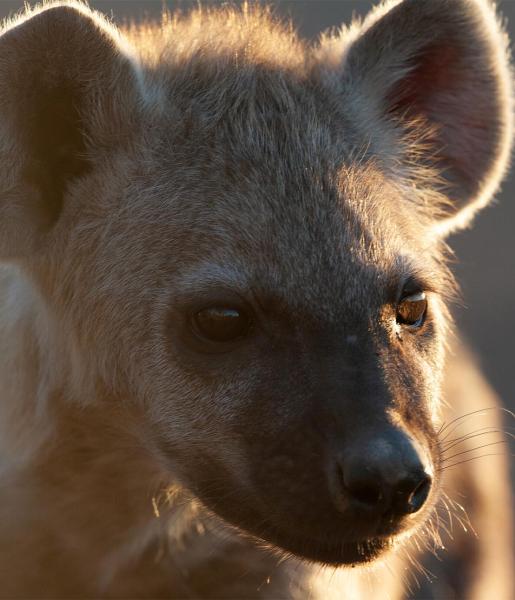
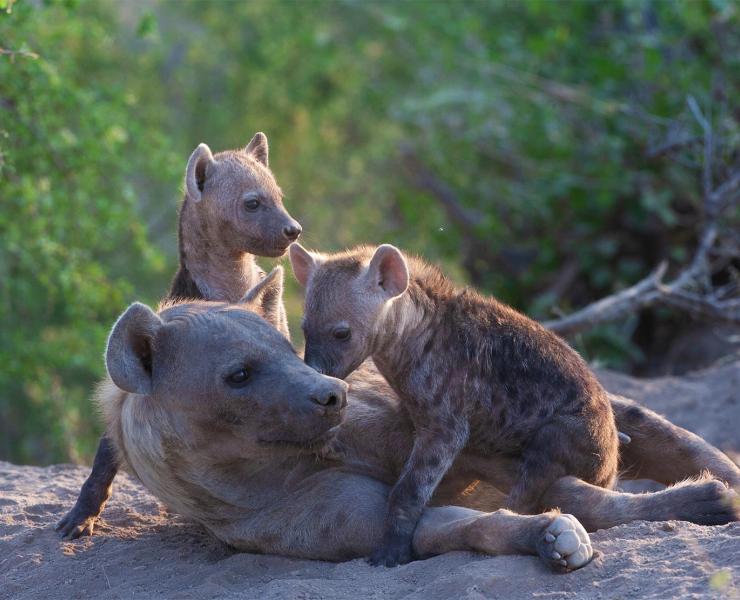
Behaviors
They have a great sense of humor.
Hyenas make a variety of vocalizations, including wailing calls, howling screams, and the well-known “laughter,” which can be heard up to five kilometers away (three miles) and is used to alert other clan members of a food source.
Hyena cubs stick close to their mothers.
They usually bear litters of two to four cubs. Cubs begin to eat meat from kills near the den at about five months, but they are suckled for as long as 12 to 18 months — an unusually long time for carnivores. This is probably a necessity, as most kills are made far from the den, and hyenas, unlike jackals and hunting dogs, do not bring back food and regurgitate it for their young. At about one year, cubs begin to follow their mothers on their hunting and scavenging forays. Until then, they are left behind at the den with a babysitting adult.
They are very territorial.
Spotted hyenas are organized into territorial clans of related individuals. The center of clan activity is the den, where the cubs are raised, and individuals meet. They mark and patrol their territories by depositing a strong-smelling substance produced by the anal glands on stalks of grass along the boundaries. “Latrines,” places where members of a clan deposit their droppings, also mark territories.
Diet
Hyenas are not picky eaters.
These carnivores are one of Africa’s top predators; however, there is a common misconception that they are primarily scavengers. On the contrary, about 70 percent of their diet is composed of direct kills. They consume animals of various types and sizes, carrion, bones, vegetable matter, and other animal droppings. Their jaws are among the strongest in relation to the size of any other mammal. Their jaws and digestive tract allow them to process and obtain nutrients from skin and bones. The only parts of prey not fully digested are hair, horns, and hooves — these are regurgitated in the form of pellets. The high mineral content of the bones makes their droppings a highly visible, chalky white. According to campers, these animals have even been known to consume aluminum pots and pans.
Habitats
Where do hyenas live?
Hyenas are widespread and found in most habitats. Spotted hyenas are found in all habitats, including savannas, grasslands, woodlands, forest edges, subdeserts, and even mountains up to 4,000 meters.
